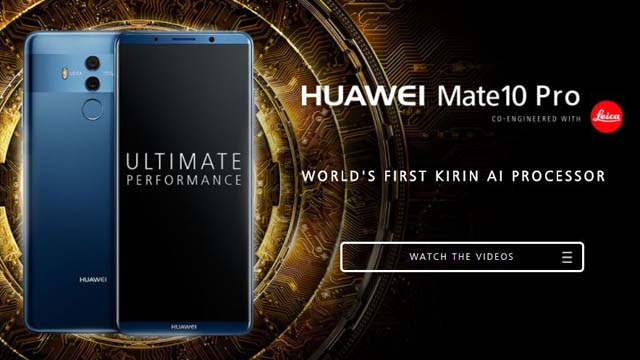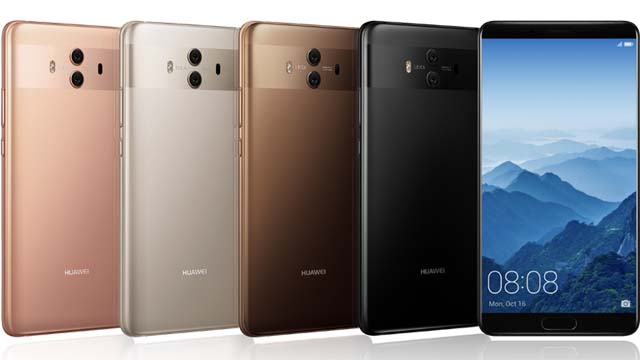Chinese smartphone maker Huawei has taken the wraps off the latest generation of their high-end smartphone series, the Mate 10 series. The Mate series of smartphones include the Mate 10, Mate 10 Pro, and Porsche Design Mate 10. With the release of the devices, Huawei pants to dethrone other manufacturer’s flagships like the Galaxy Note 8.
By design, the Mate 10 Pro and Porsche Design Mate 10 are the same phones, with the latter having a ‘Porsche’ touch. So, the only difference exists between the Mate 10 and the Mate 10 Pro. The main difference between the devices is their shape and screen size. Both devices have a glass back with curved sides and a familiar reflective band across the back. Both devices follow the almost no-bezel trend of 2017 while taking the edge with their new thinking tech.
The Huawei Mate 10’s dimensions are 150.5 x 77.8 x 8.2mm, and it weighs 186g, while the Huawei Mate 10 Pro measures 154.2 x 74.5 x 7.9mm and weighs 178g, making it bigger, slimmer, and lighter by a smaller range. The two devices are also available in different color variants. The Mate 10 is available in three color variants: Mocha Brown, Black, Champagne Gold, and Pink Gold, while the Mate 10 Pro will be available in Midnight Blue, Titanium Gray, Mocha Brown, and Pink Gold color variants. The Mate 10 Pro is also dust and IP67-certified water resistant. However, the Porsche Design Huawei Mate 10 only comes in Diamond Black color with 6GB RAM and 256GB storage.
Coming to its display, the Huawei Mate 10 has a 5.9-inch Quad HD (2560 x 1440) LCD with a pixel density of 499 pixels per inch, while the Huawei Mate 10 Pro and Porsche Design Mate 10 sport a 6.0 inch Full HD+ OLED display with a pixel density of 402 pixels per inch. They have 16:9 and 18:9 aspect ratios respectively. Both the devices run an octa-core HiSilicon Kirin 970 chipset with four cores running at 2.36GHz and four clocked at 1.8GHz and an i7 co-processor under the hood. They both use the new neural network processing unit (NPU), similar to the Apple iPhone’s processor, designed to improve performance and efficiency using AI.
Richard Yu, CEO of the company’s Consumer Business Group, claimed their processor is much stronger than the A11 Bionic Apple has just released in its latest iPhones. They have more than double the performance power. Users are in for the much faster performance, longer battery life, and more compact design. The Kirin 970 is the first in a series of new advances to bring powerful AI features to their devices and take them beyond the competition. He also added that The HiSilicon Kirin 970 SoC is so powerful that we can connect the device to a monitor and turn it into a PC without a dock. Once done, the phone can also serve as a mouse. Huawei claims to rely mainly on the cloud instead of the smartphone system so that the data is not lost. A Mali-G72 Mp12 GPU backs the processor in the graphics department. The RAM content also differs. The Mate 10 has 4GB of RAM and 64GB of storage, while the Mate 10 pro is available in two variants: 4GB of RAM and 64GB of storage and 6GB of RAM and 128GB of storage.
Moving to the optics department, the Huawei Mate 10 and the Huawei Mate 10 Pro sport a 20MP monochrome and 12MP color dual-lens camera using Leica SUMMILUX-H lenses with AI-powered bokeh on the backside. We can use ‘2x hybrid zoom’ but still use 4-way focus (PDAF, CAF, Laser, Depth). The cameras sport AI-powered image stabilization object recognition and a large f/1.6 aperture. Huawei dreams that the smartphone camera will replace the DSLR because it’s not bulky like a professional camera. That’s why they put the AI processor on their phone. With the AI processor, they can do more and more things. It means the phone’s camera is more like human eyes, recognizing and perceiving objects—the GPU on the device. The camera power manages things like rendering the image on a viewfinder. The NPU helps in object recognition. The AI reduces human effort and makes night and low-light photography a breeze. It contains an 8-megapixel camera for selfies and video calling on the front.
The Huawei Mate 10 comes with a 3.5mm headphone jack. But the Mate Pro doesn’t and has a USB Type-C in its place. Also, like the Samsung DeX, Huawei supports a mirror or extension experience to a large display via a USB Type-C dock solution. Both devices feature a fingerprint sensor on the back and run on EMUI 8.0, based on Android 8.0 Oreo. They both feature NFC also. A 4000mAh battery with support from supercharging backs the two devices and the Porsche edition.
About the pricing, Huawei has priced the Mate 10 at €699 ( Rs 53,560 approx), €799 ( Rs 61.230) for the Mate 10 Pro, and a shocking $1,395 (Rs 90,975 approx) for the Porsche Design Mate 10 Pro. There is no word on an official US or Indian release, but it’s expected to be released soon, considering Huawei’s aggressive expansion to the Indian market.




